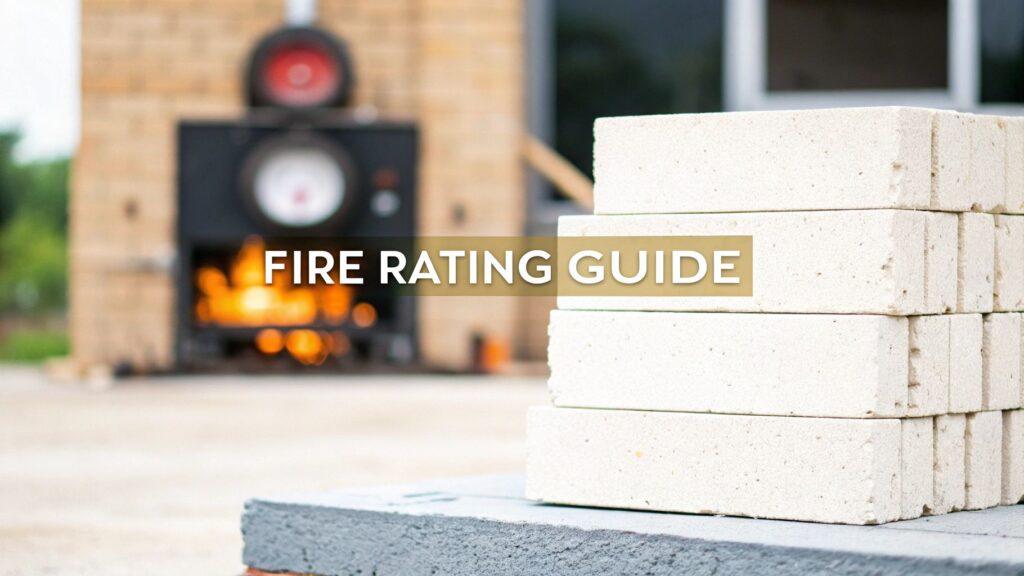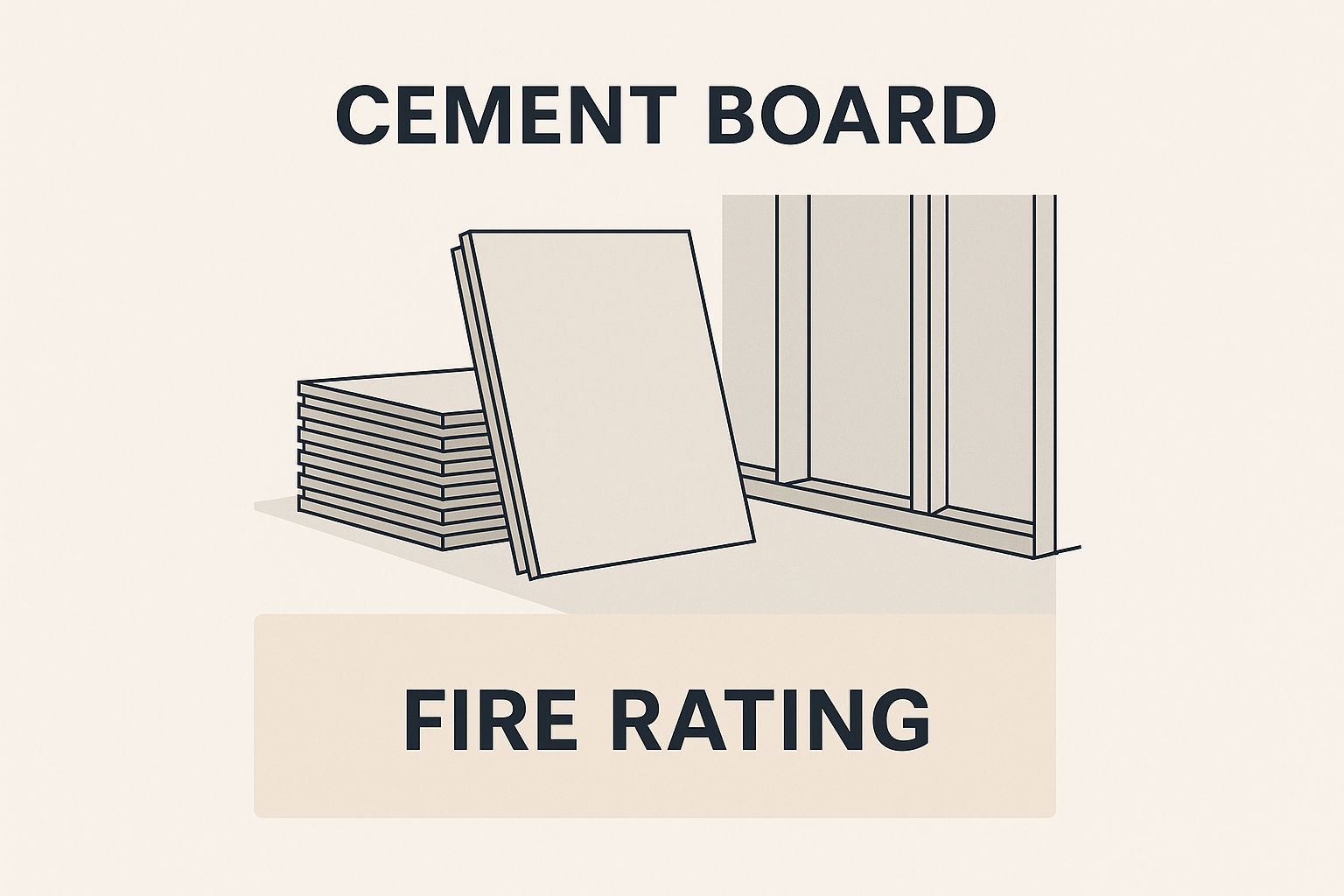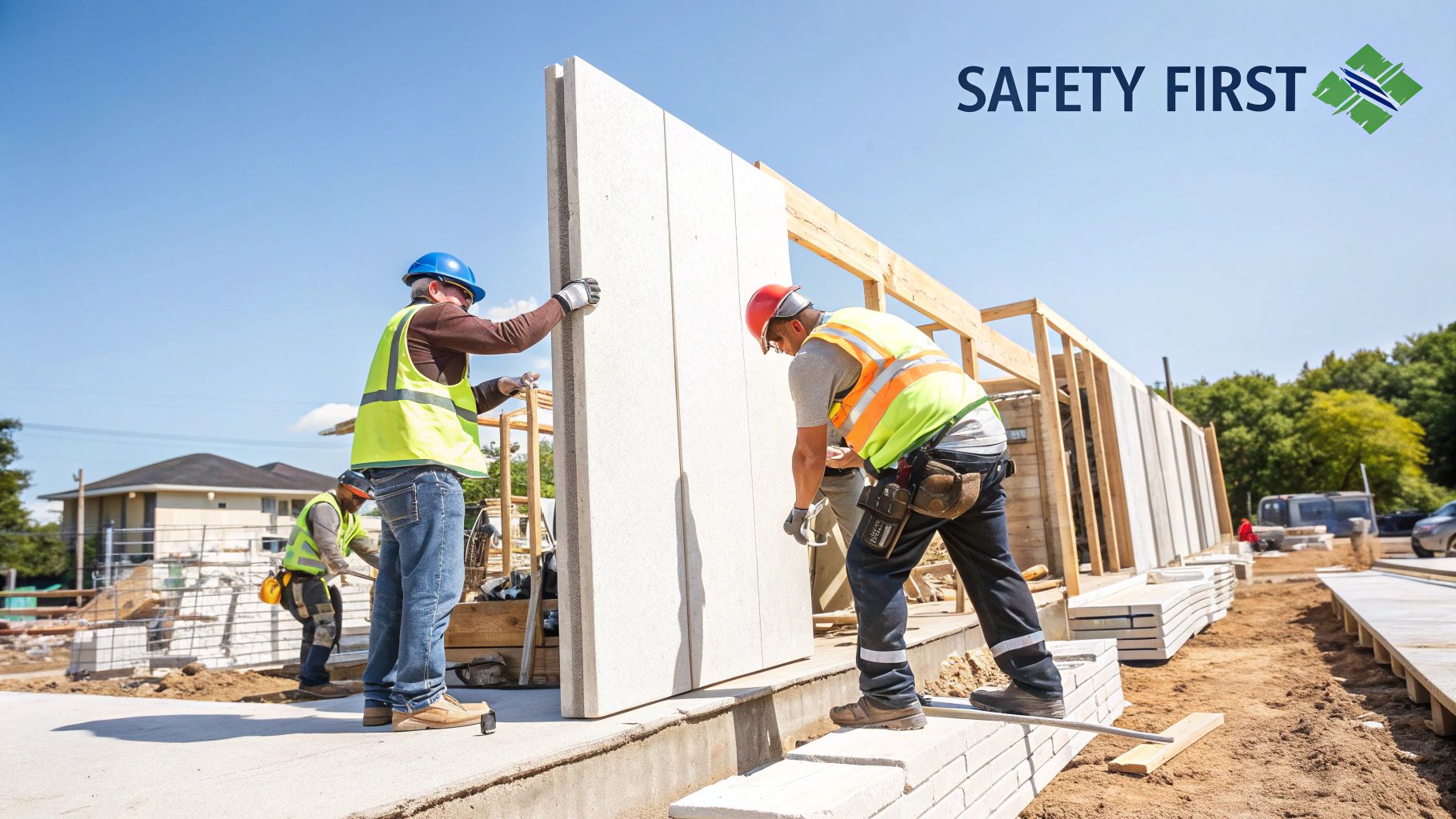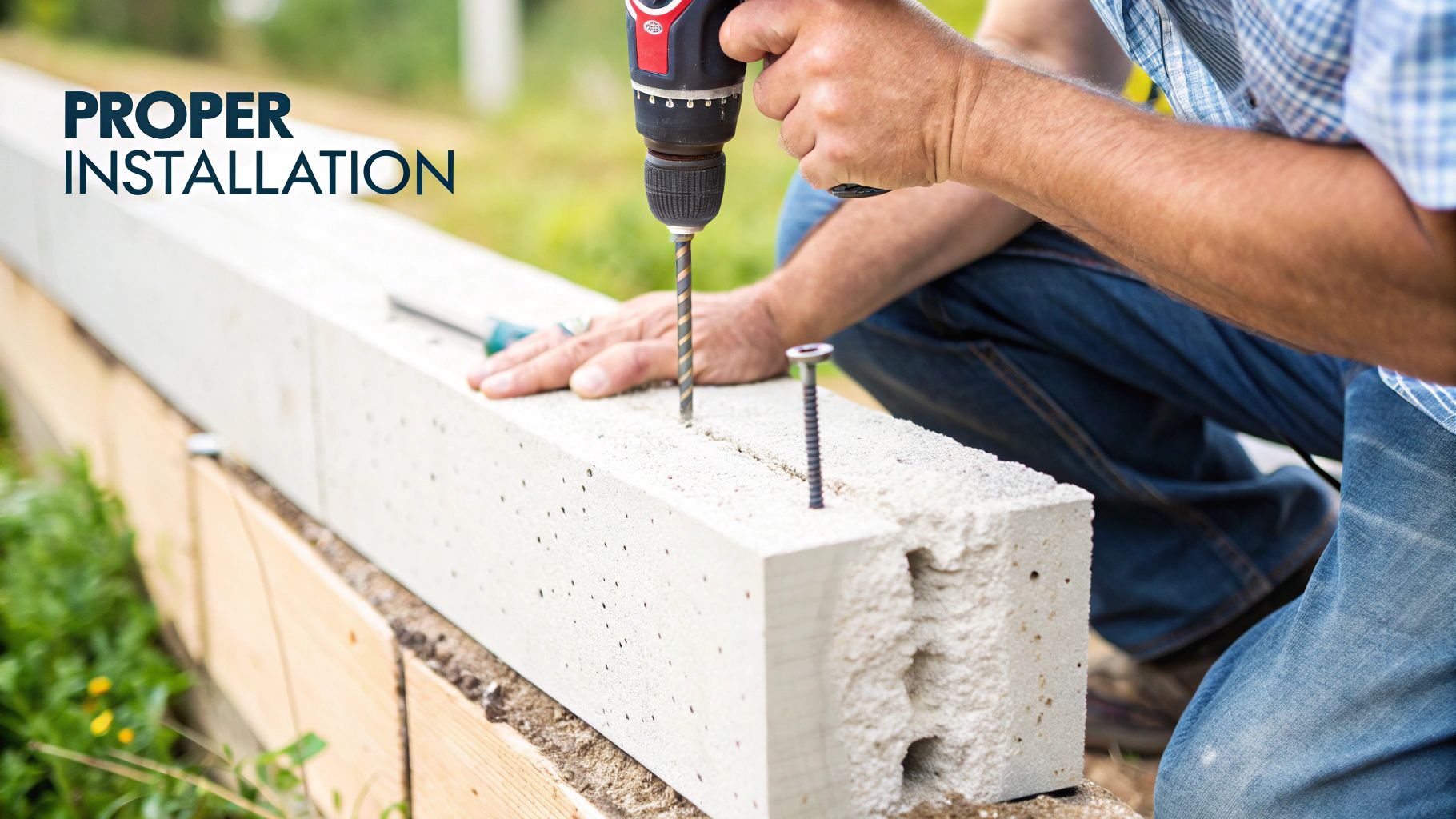Why Fire Ratings Are Your Building's First Line of Defense
Imagine you're designing a school. Not just desks and hallways, but the very fabric of the building itself. If a fire breaks out, the materials you choose will determine what happens next. That cement board you specified? It's not just a building material; it's a crucial line of defense. Think of fire resistance ratings as a material's performance report under fire, telling you how long it can withstand extreme heat.
These ratings aren't just abstract numbers; they translate directly to safety and survival. The difference between a 60-minute rating and a 90-minute rating can be the difference between a contained fire and a devastating loss. Understanding cement board fire resistance ratings empowers you to design buildings that protect lives and property.
Let's take a kitchen fire, for example. Cement board with a higher fire resistance rating, installed behind your stovetop, can slow the spread of flames to the wall studs and the rest of the house. Those extra minutes are invaluable, providing occupants more time to escape and giving firefighters a critical advantage.
The importance of fire-resistant materials has been tragically highlighted by events like the Grenfell Tower fire. This disaster, a stark reminder of the dangers of combustible cladding, has driven changes in building codes worldwide. In Australia, the demand for fire-resistant materials like fibre cement has surged, especially in bushfire-prone areas. These changes align with stricter standards like AS 3959 and the NCC’s focus on non-combustible materials. Discover more insights on facade fire compliance. Even seemingly unrelated choices, like mounting a TV outdoors, require considering the environment and material durability. Here's a guide on how to mount a TV outside.
Choosing the right cement board isn’t just about checking a box on a compliance form. It's a fundamental design decision that impacts the safety and resilience of the entire building. If you're interested in learning more about sustainable building practices, you might find this helpful: eco-friendly building materials. Ultimately, understanding fire resistance ratings is the first step towards creating safer, more resilient structures.
Inside The Fire Lab: How Testing Really Works
Ever wondered what it's like to put cement board through trial by fire? Imagine a giant oven, cranked up to 1000°C, not just blasting heat but following a carefully designed temperature curve that mimics a real-world blaze. It's a meticulously controlled environment where technicians track dozens of sensors, gathering data on everything from how the board holds its shape to how much heat sneaks through. Understanding how materials react in these extreme conditions is critical, much like knowing how features like hurricane rated windows and doors contribute to a building’s ability to withstand extreme weather.
There's more to it than just surviving the inferno. Cement board, like any fire-resistant material, is evaluated on three key performance aspects: structural adequacy, integrity, and insulation. Think of it as a building material triathlon. Will it stay standing strong (structural adequacy)? Will it keep the flames from spreading through (integrity)? And will it protect the other side from getting hot enough to ignite (insulation)? A passing grade requires top performance across all three.
The infographic above visually represents the concept of a fire resistance rating. It shows how this rating becomes a critical part of the material’s identity in construction. This visual emphasizes the vital role cement board plays in building safety.
A material might ace one part of the test but struggle in another. This is what makes understanding cement board fire resistance rating so complex. For example, a board might hold its shape perfectly but allow too much heat to transfer, failing the insulation test.
Understanding Fire Resistance Ratings
These rigorous tests often adhere to standards like ASTM E119. These standards provide the data that ultimately translate into those fire resistance ratings you see on product specifications. This information empowers architects and builders to choose materials that meet strict fire safety codes.
Let's look at a comparison of some common fire testing standards:
To help you understand how different testing methods work, we've put together a handy comparison table:
Fire Testing Standards Comparison For Cement Board
How different testing methods evaluate cement board fire resistance with specific criteria and real-world applications
| Test Standard | Temperature Profile | Duration Options | Key Measurements | Typical Applications |
|---|---|---|---|---|
| ASTM E119 | Standard Time-Temperature Curve | Up to 4 hours | Structural integrity, heat transmission, hose stream test | Walls, floors, ceilings, roofs |
| UL 263 | Similar to ASTM E119 | Up to 4 hours | Similar to ASTM E119, but may include specific assembly requirements | Similar to ASTM E119 |
| CAN/ULC-S101 | Similar to ASTM E119 | Up to 4 hours | Similar to ASTM E119, adapted for Canadian building codes | Similar to ASTM E119, specifically for Canadian construction |
The table above highlights the similarities and differences between different fire testing standards for cement board. While they all evaluate structural integrity and heat transmission under controlled fire conditions, variations exist in the specifics of the temperature curves, duration options, and additional requirements based on regional codes and applications.
These ratings aren't just numbers on a page. They represent a crucial layer of safety and real-world performance in a fire scenario. They offer peace of mind, knowing that building materials have been thoroughly vetted under extreme conditions.
Navigating Australian Building Codes Without The Headaches
Australian building codes, especially the National Construction Code (NCC), are vital for ensuring fire safety. Think of them as a collection of best practices, a framework developed from years of experience and research, not just red tape. They guide us toward creating safer buildings for everyone. Let's break down the jargon and make these guidelines easier to understand and use.
Decoding The NCC and AS 3959
A key document you'll encounter is AS 3959, which focuses specifically on construction in bushfire-prone areas. This standard details the materials and construction methods designed to resist bushfire attacks. Understanding this standard is essential for anyone building in these higher-risk locations. It's about understanding the reasoning behind the rules, not just following them blindly.
The NCC works alongside AS 3959 by outlining general fire resistance requirements for all buildings, no matter where they’re located. It offers two main paths: deemed-to-satisfy solutions and performance-based approaches. Deemed-to-satisfy solutions are like pre-approved blueprints that automatically meet the NCC requirements, offering a simpler route to compliance. Performance-based solutions, however, allow for more creative designs but demand detailed engineering analysis to prove they meet the code.
In Australia, cement board is well-regarded for its fire resistance, especially when considering building codes and regulations. The NCC plays a crucial role in setting the fire resistance standards for building materials, including cement boards. For example, James Hardie fiber cement products are known to achieve fire resistance ratings of up to two hours in specific wall systems. This is important because it aligns with the NCC’s fire safety goals to protect people and prevent fires from spreading. The fire performance of fiber cement is especially valuable in bushfire-prone areas, as detailed in compliance documents like AS 3959. Discover more insights on cement board fire performance.
Working With Building Surveyors
Navigating these codes might seem complicated, but working with building surveyors is crucial. Experienced builders and designers often consult with surveyors early in the design phase. This proactive partnership ensures compliance from the get-go, avoids costly revisions later, and ensures the project meets all the regulations. It's about collaboration, not confrontation.
Australian Standards: Adapting to Unique Conditions
Australian standards, while often drawing from international codes, are tailored to our specific climate and risks, such as bushfires and cyclones. This localized approach ensures our building regulations address the unique challenges Australian builders face. This adaptation is vital, making certain our buildings aren't just compliant, but also resilient against our diverse environmental conditions.
Cement Board Showdown: Which Products Actually Deliver
Let's talk fire resistance and cement boards. It's a topic shrouded in marketing hype, where every product claims to be a fortress against flames. But the reality? It's more complex than that. The true fire performance of a cement board depends on a delicate balance of factors: what it's made of, how it's put together, and even how it's installed. Let's break down these elements and learn how to spot real fire protection from clever sales tactics.
Decoding the Differences in Cement Board Fire Resistance Ratings
Imagine two seemingly identical cement boards. One crumbles under fire, the other holds strong. Why? One key difference often lies in the fiber content. Think of fibers like the steel rods reinforcing concrete—they dramatically impact the board's strength and how it handles heat. Some boards use cellulose fibers, others fiberglass. This seemingly small distinction significantly affects fire test performance. Generally, more fiber means better structural integrity at high temperatures, maintaining that critical protective barrier.
Another critical factor is density. Picture a dense forest acting as a natural firebreak. Similarly, a denser cement board provides superior fire resistance. These boards pack more cement and less air, creating a tougher barrier against heat transfer. This keeps the unexposed side cooler, reducing the risk of fire spreading through walls or ceilings.
Even with the perfect board, installation matters. Imagine a top-of-the-line, fire-resistant board installed with gaps or flammable sealant. The whole system's effectiveness is compromised. Incorrect fastener spacing or poor joint taping creates weak points for fire to penetrate. Proper installation, following manufacturer guidelines and building codes, is just as crucial as the board itself.
When dealing with construction, understanding local building codes is essential, particularly in places with specific regulations like Dubai. For insights into these codes, refer to resources like Dubai building codes. In Australia, fire-resistant cladding has gained significant importance, especially after fires involving combustible materials. Cemintel's fiber cement products are considered non-combustible under the Building Code of Australia (BCA), specifically clauses C1.9 and part 3.7.1.2. This compliance is vital for meeting stringent fire safety standards. For more information on concrete board, see concrete board.
To help you make informed choices, we’ve compiled a comparison of popular cement board products. The table below provides a side-by-side look at their fire ratings, installation needs, and best-fit applications.
Real-World Cement Board Fire Performance Comparison
Side-by-side analysis of popular cement board products showing actual fire ratings, installation requirements, and best-fit applications
| Product Category | Tested Fire Rating | Thickness Range | Installation Requirements | Optimal Applications |
|---|---|---|---|---|
| Type X Cement Board | 1-hour | 1/2" – 1" | Specific fastener type and spacing, taped joints | Fire-rated walls and ceilings |
| Fiber-Reinforced Cement Board | 2-hour | 1/4" – 1" | Manufacturer-specified sealant and fasteners | Exterior sheathing, soffits |
| Standard Cement Board | Non-rated | 1/4" – 1/2" | Similar to drywall installation | Tile backer board, underlayment |
This table highlights the importance of selecting the right cement board based on the specific fire resistance requirements of your project. Type X boards, for example, are specifically designed for fire-rated assemblies, while fiber-reinforced options offer a balance of fire resistance and other performance characteristics.
Understanding cement board fire resistance ratings isn't about just finding the cheapest option. It's about making smart decisions that prioritize safety and performance. It's about building with confidence, knowing you've chosen materials that truly deliver when it matters most.
When Fire Ratings Save Lives: Real Stories From The Field
Fire resistance ratings for cement board aren't just numbers on a data sheet. They're a lifeline. Think of them as a promise of protection, a guarantee of how long a material can stand up to the intense heat of a fire. The image below, from Wikipedia's Fire-resistance rating page, shows how these ratings are organized and standardized across the globe.
The table in the image breaks down the different ratings and their corresponding times, highlighting how structures are evaluated based on things like their ability to hold weight and how quickly flames spread across them. This standardization is key for making sure safety measures are consistent across different building codes and in different parts of the world.
Imagine two houses next to each other in a bushfire-prone region. One is clad in standard timber, the other in cement board with a high fire resistance rating. When a bushfire roars through, the timber house ignites rapidly. But the cement board house holds strong, acting as a vital shield. This gives the family inside precious time to escape and firefighters a fighting chance to save the structure. This scenario illustrates how choosing materials with appropriate cement board fire resistance ratings can truly mean the difference between losing everything and getting to safety.
Real-World Examples of Fire Resistance in Action
Let's take a look at a real apartment fire that occurred in Melbourne. The fire started in a kitchen but was thankfully confined to a single unit. Why? Fire-rated cement board had been installed behind the stovetop. This simple precaution stopped the flames from spreading to neighboring apartments, a powerful example of how these ratings translate into real-world safety. This localized containment stands in stark contrast to tragedies like the Grenfell Tower fire, where inadequate cladding materials contributed to the rapid spread of the blaze.
In another incident, a school fire in Sydney demonstrated the life-saving potential of fire-rated materials. Fire-rated cement board walls in the school hallways created a protected escape route for students and staff. These walls maintained their integrity for those critical minutes needed for everyone to evacuate safely. This underscores the vital role of fire-rated assemblies in public buildings. Fire chiefs will often tell you that these extra few minutes are absolutely critical, affecting both evacuation strategies and the safety of first responders.
The Importance of Proper Installation and Maintenance
Even the highest cement board fire resistance rating means nothing if the board is installed incorrectly. A commercial building fire in Brisbane revealed a harsh lesson. Investigators discovered that improperly installed cement board had allowed the fire to bypass what should have been a protective barrier. This highlights the critical need for precise attention to detail during construction and regular inspections to ensure fire-rated systems remain effective. Even seemingly minor details like the type of sealant used or the spacing of fasteners can have a major impact on how fire-rated assemblies perform in a real fire.
These real-world examples show why understanding and applying cement board fire resistance ratings in construction is so important. It's not just about ticking boxes on a building code checklist; it's about making informed choices that protect lives and property. For more ideas on incorporating fire-resistant materials into your projects, check out manufactured stone benefits and installation.
Fire Rating Myths That Could Cost You Everything
The construction industry is constantly evolving, but some stubborn myths about fire resistance just won't go away. These misconceptions can be seriously problematic, leading to expensive errors and compromised safety. Let's dismantle some common myths about cement board fire resistance ratings and get to the facts about effective fire protection.
Myth 1: Non-Combustible Means Fireproof
Many people assume that "non-combustible" equals "fireproof." This is a dangerous oversimplification. Non-combustible simply means a material won't add fuel to the fire by igniting itself. It doesn't mean it won't break down under high heat. Think of a steel beam in a fire. It won't burst into flames, but it can weaken and buckle under intense temperatures. Cement board is similar. It's non-combustible, but it will eventually deteriorate under sustained, extreme heat. Understanding this distinction is essential for selecting the right fire protection for your project.
Myth 2: Thicker is Always Better
Thicker cement board usually offers better fire resistance, but it's not as straightforward as "thicker = better." A thicker board does provide more thermal mass, which slows the transfer of heat. But other factors like the type of fiber reinforcement and the board’s density also play key roles. Simply choosing the thickest board without considering these other factors can be an expensive and unnecessary overspend. A more effective strategy considers all material properties to find the right balance.
Myth 3: Lab Tests Tell the Whole Story
Lab tests like the ASTM E119 standard are crucial for evaluating cement board fire resistance ratings. They give us controlled, standardized data. However, these lab conditions don't fully replicate the chaos of a real-world fire. Things like ventilation, the surrounding temperature, and the specific building materials used can all affect how cement board performs in an actual fire. Think of it like crash-testing a car. It provides valuable information, but real-world accidents happen under far more varied conditions. While lab tests are important, we need to consider how those results translate to real-world applications.
Myth 4: Installation Doesn’t Matter
Even with the highest cement board fire resistance rating, proper installation is paramount. Imagine a top-of-the-line fire-rated board installed with gaps or the wrong sealant. These seemingly small mistakes create weak points that compromise the entire fire protection system. Even something as simple as incorrect fastener spacing can have major repercussions during a fire. Like a chain being only as strong as its weakest link, the effectiveness of a fire-rated assembly hinges on the meticulous execution of every detail. Following manufacturer guidelines and hiring qualified installers is non-negotiable.
By understanding these common misconceptions and focusing on the facts about cement board fire resistance ratings, you can make smart decisions. These choices protect your projects, your professional reputation, and, most importantly, the people who use the buildings you create. Addressing these misunderstandings head-on is the first step toward designing safer and more resilient structures.
Your Complete Guide To Smart Fire Rating Decisions
Ready to put your cement board fire resistance knowledge into action? This guide will reshape how you approach choosing materials, giving you a practical framework for evaluating your project’s fire safety needs. We’ll walk you through everything, from understanding building codes to assessing on-site risks, empowering you to make informed choices. You'll become proficient in interpreting test results, asking suppliers the right questions, and spotting red flags with subpar products.
Assessing Your Fire Safety Requirements
First, let's pinpoint your project's particular needs. A high-rise apartment in Melbourne will have different fire safety requirements than a single-family home near bushland. Building codes, like the NCC, dictate the necessary fire resistance levels for various building types. Think about factors like occupancy, the building’s height, and how close it is to other structures. A hospital, for example, needs a higher fire rating than a warehouse because the people inside are more vulnerable.
Deciphering Test Reports and Supplier Claims
Next, let’s learn to read cement board fire resistance rating test reports like an expert. Look for ratings based on established standards like ASTM E119. Keep in mind, a higher rating isn’t always better. A two-hour rating might be excessive for a low-risk project. It’s about balancing performance with practicalities like budget and how difficult installation is. When you talk to suppliers, ask specific questions about how the product was tested, what kind of fibers are in it, and how they recommend installing it. Be cautious of vague statements or products without proper certification. For more information on other fire-resistant options, check out resources like manufactured stone benefits and installation.
Balancing Fire Performance and Practical Considerations
Fire safety is critical, but it’s not the only thing to consider. Think about the compromises between different cement boards. Lightweight boards are easier to work with, but denser boards offer better fire protection. It’s a bit like choosing between a compact car and a rugged truck – both are great, but they excel in different situations. The best cement board depends on the project. Don't forget aesthetics. Some boards are better for painting or textured finishes, while others work best with tile. The aim is to find a product that meets both your fire safety needs and your design goals.
Documentation and Compliance
Keeping good records is vital for staying compliant. Hold onto copies of test reports, installation guides, and inspection certificates. These documents demonstrate you've done your homework and protect you if any disagreements or insurance claims arise. Working closely with building inspectors and fire engineers simplifies the approval process and prevents costly revisions. Think of it as teamwork, not a battle. Addressing their concerns early saves time and keeps the project moving. Building a fire-safe structure isn’t just about choosing the right materials; it’s about creating a whole system for fire safety. This protects your project, your reputation, and, most importantly, the people who will use the building.
Ready to explore innovative and sustainable building materials? Flomary Group offers a range of ultra-thin stone veneer and flexible tiles, blending the beauty of natural stone with advanced lightweight technology. See how our environmentally friendly products can improve your next project.






